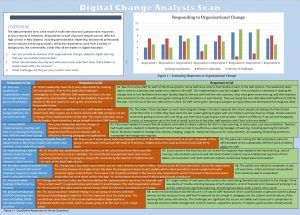In my near future I will be spearheading a program, where, if I am honest, and if I use one of the many change readiness tools created by my fellow MALAT cohort, I would say that my organisation is not ready for such a change. However, I want this change because it will make my day to day easier, and it is happening whether I am on board or not. So, I hope to make the best of this opportunity, and prove that I have learned something about leading digital change. If successful, I hope that this will be the first step down a new career path for me.
At the outset of this course, I did not fancy myself a leader, and nearing its conclusion I would say that not much has changed in that regard. What has changed is an improved sense, not of what it takes to be a leader, but a knowledge of the process of leading. I would not say I have gained any charisma, or specific leadership skill, but I now know better what considerations needs to be taken into account to effectively manage people and ideas, which is ultimately what leadership is all about. Continue reading The Continuing Growth and Education of Marshall Hartlen: Digital Savant
 In secondary education these days there is a big push to incorporate educational technology in the classroom. Economic reality dictates creative solution for any school managing this, particularly large schools catering to more than 1000 students. Operating budgets cannot keep up with the cost and rapid change of devices required for classroom use. Smaller schools have been able to manage this change better, when the school board that serves the pieces of operational pie capital is adequately managed and funded. To deal with spiralling operating overhead, operating costs get outsourced to parents who now are expected to purchase devices for their children in the same way they are expected to purchase stationery (the politics of this can be discussed on Facebook or Twitter as it will detract from the purpose of this post!)
In secondary education these days there is a big push to incorporate educational technology in the classroom. Economic reality dictates creative solution for any school managing this, particularly large schools catering to more than 1000 students. Operating budgets cannot keep up with the cost and rapid change of devices required for classroom use. Smaller schools have been able to manage this change better, when the school board that serves the pieces of operational pie capital is adequately managed and funded. To deal with spiralling operating overhead, operating costs get outsourced to parents who now are expected to purchase devices for their children in the same way they are expected to purchase stationery (the politics of this can be discussed on Facebook or Twitter as it will detract from the purpose of this post!)
 The digital age is changing the way life is conducted. We learn differently. We access information differently. We work differently. We exist, differently. All of these realities, and we are still changing, so, how to manage this? Are we hanging on to the organisational structurees of work-life-education as a last vestige, a sentinel against the great digital unknown? The various mediums for life in the 21st century are constantly moving forward like a Space X rocket, but we are in many ways being guided through this journey by a gasoline powered engine because it is familiar. The rocket will carry us into unknown and potentially dnagerous new realms, but what marvels we will experience on the journey! The trusty old engine will get us somewhere reliable familiar and safe, but we will never reach the depths of untapped potential of the rocket. This is the challenge of managing and leading in the digital age.
The digital age is changing the way life is conducted. We learn differently. We access information differently. We work differently. We exist, differently. All of these realities, and we are still changing, so, how to manage this? Are we hanging on to the organisational structurees of work-life-education as a last vestige, a sentinel against the great digital unknown? The various mediums for life in the 21st century are constantly moving forward like a Space X rocket, but we are in many ways being guided through this journey by a gasoline powered engine because it is familiar. The rocket will carry us into unknown and potentially dnagerous new realms, but what marvels we will experience on the journey! The trusty old engine will get us somewhere reliable familiar and safe, but we will never reach the depths of untapped potential of the rocket. This is the challenge of managing and leading in the digital age. 